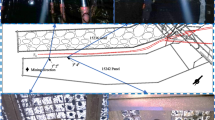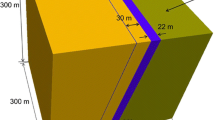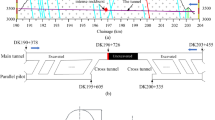Abstract
Fault slips and triggered rockbursts pose a significant threat to the safety of mining personnel and infrastructure in deep coal mines. Sudden and dynamic slip may occur along a pre-existing fault characterized by the presence of contact between two opposite faces. Such slips are capable of changing the balance of forces when mining activity is conducted in the area surrounding the fault at depth and are accompanied by energy release that has the potential to cause serious damage to roadways and working faces. The aim of the comprehensive investigation reported here was to elucidate the evolution of the stress field surrounding a fault due to mining activity in adjacent working faces, using Fast Lagrangian Analysis of Continua in 3 Dimensions (FLAC3D) numerical simulations, especially variations the high shear stress area. We then proposed the mining-induced fault slip mechanism. The evolution rule of sources during fault slip could be clearly explained using field microseism (MS) monitoring data, and the correlation between source parameters (e.g., static stress drop, peak particle velocity, and displacement) and fault slip was established. Correspondingly, the multi-parameter precursors of a rockburst induced by the fault slip were analyzed and summarized in detail. This work provides a number of reference points to be used for the warning and controlling of rockbursts triggered by fault slip in coal mines.













Similar content being viewed by others
References
Beeler NM, Tullis TE, Blanpied ML, Weeks JD (1996) Frictional behavior of large displacement experimental faults. J Geophys Res 101:8697–8715
Beeler NM, Tullis TE, Junger J, Kilgore B, Goldsby D (2014) Laboratory constraints on models of earthquake recurrence. J Geophys Res 119:8770–8791
Benson PM, Vinciguerra S, Meredith PG, Young PR (2010) Spatio-temporal evolution of volcano seismicity: a laboratory study. Earth Planet Sci Lett 297:315–323
Blake W, Hedley DGF (2003) Rockbursts: case studies from north American hard-rock mines. Society for Mining, Metallurgy, and Exploration, Inc., Littleton
Blanpied ML, Lockner DA, Byerlee JD (1995) Frictional slip of granite at hydrothermal conditions. J Geophys Res 100:13045–13064
Board M, Rorke T, Williams G, Gay N (1992) Fluid injection for rockburst control in deep mining. Tillerson JR & Wawersik WR (Eds.) Proceedings of the 33rd U.S. Symposium on Rock Mechanics. A. A. Balkema, Rotterdam, pp 111–120
Boatwright J, Fletcher JB (1984) The partition of radiated energy between P and S waves. Bull Seismol Soc Am 74:361–376
Dieterich J (1981) Constitutive properties of faults with simulated gouge D.C. In: Carter NL et al. (Eds.) Mechanical behavior of crustal rocks. Geophys Monogr Ser 24:102–120
Faulkner D, Jackson C, Lunn R, Schlische R, Shipton Z, Wibberly C (2010) A review of recent developments concerning the structure, mechanics and fluid flow properties of fault zones. J Struct Geol 32:1557–1575
Frid V, Shabarov A, Proskurjakov V (1992) Formation of electromagnetic radiation in coal stratum. J Min Sci 28:139–145
Goebel THW, Becker TW, Schorlemmer D, Stanchits S, Sammis C, Rybacki E, Dresen G (2012) Identifying fault heterogeneity through mapping spatial anomalies in acoustic emission statistics. J Geophys Res Solid Earth 117:1–18
He MC, Miao JL, Feng JL (2010) Rock burst process of limestone and its acoustic emission characteristics under true-triaxial unloading conditions. Int J Rock Mech Min Sci 47:286–298
Hu QT, Zhou SN, Zhou XQ (2008) Mechanical mechanism of coal and gas outburst process. J China Coal Soc 33:1368–1372
Ikari M, Saffer D (2011) Comparison of frictional strength and velocity dependence between fault zones in the Nankai accretionary complex. Geochem Geophys Geosyst 12:239–241
Kaiser PK, Valley B, Dusseault MB, Duff D (2013) Hydraulic fracturing mine back trials—design rationale and project status. Jeffrey R, Bunger AP, McLennan J (Eds.) Effective and sustainable hydraulic fracturing. IntechOpen, London, pp 877–890
Karner SL, Marone C (1998) The effect of shear load on frictional healing in simulated fault gouge. Geophys Res Lett 25:4561–4564
Lu CP, Liu Y, Zhang N, Zhao TB, Wang HY (2018) In-situ and experimental investigations of rockburst precursor and prevention induced by fault slip. Int J Rock Mech Min Sci 108:86–95
Mair M, Marone C, Young RP (2007) Rate dependence of acoustic emissions generated during shear of simulated fault gouge. Bull Seismol Soc Am 97:1841–1849
Malek F, Trifu C, Suorineni FT, Espley S, Yao M (2008) Management of high stress and seismicity at Vale Inco Creighton Mine. Amadei B, Kranz RL, Scott GA, Smeallie PH (Eds.) Proceedings of the 42nd U.S. Rock Mechanics Symposium. American Rock Mechanics Association, Alexandria, pp 8
McGarr A, Spottiswoode SM, Gay NC, Ortlepp WD (1979) Observations relevant to seismic driving stress, stress drop, and efficiency. J Geophys Res Solid Earth 84:2251–2261
McKinnon SD (2006) Triggering of seismicity remote from active mining excavations. Rock Mech Rock Eng 39:255–279
Mclaskey GC, Lockner DA (2016) Calibrated acoustic emission system records M −3.5 to M −8 events generated on a saw-cut granite sample. Rock Mech Rock Eng 49:4527–4536
Moore DE, Summers R, Byerlee JD (1990) Deformation of granite during triaxial friction tests. Rossmanith HP (Ed) Proceedings of the International Conference on Mechanics of Jointed and Faulted Rock, A. A. Balkema, Rotterdam, pp 345–352
Niemeijer A, Toro DG, Nielsen S, Felice FD (2011) Frictional melting of gabbro under extreme experimental conditions of normal stress, acceleration and sliding velocity. J Geophys Res 116:117–130
Ortlepp W (1992) Note on fault-slip motion inferred from a study of micro-cataclastic particles from an underground shear rupture. Pure Appl Geophys 139:677–695
Ortlepp WD (2000) Observation of mining-induced faults in an intact rock mass at depth. Int J Rock Mech Min Sci 37:423–436
Paige ES, Laurent G, Stephen DM (2013) The role of geologic structure and stress in triggering remote seismicity in Creighton Mine, Sudbury, Canada. Int J Rock Mech Min Sci 58:166–179
Price RA (1988) The mechanical paradox of large overthrusts. Geol Soc Am Bull 100:1898–1908
Read MD, Ayling MR, Meredith PG, Murrell SAF (1995) Microcracking during triaxial deformation of porous rocks monitored by changes in rock physical properties, II. Pore volumometry and acoustic emission measurements on water-saturated rocks. Tectonophysics 245:223–235
Savage JC, Lockner DA, Byerlee JD (1996) Failure in laboratory fault models in triaxial tests. J Geophys Res 101:22215–22224
Schmidt ES (2018) Experimental and numerical investigation of hydraulic simulation as a risk mitigation technique for fault slip rockburst hazards in deep underground mining [Master thesis]. The University of British Columbia, Vancouver
Shen B, King A, Guo H (2008) Displacement, stress and seismicity in roadway roofs during mining-induced failure. Int J Rock Mech Min Sci 45:672–688
Shimamoto T, Tsutsumi A (1994) A new rotary-shear high-speed frictional testing machine: its basic design and scope of research. J Tecton Res Group Jpn 39:65–78 (in Japanese with English abstract)
Sjöberg J, Perman F, Quinteiro C, Malmgren L, Dahnér-Lindkvist C, Boskovic M (2012) Numerical analysis of alternative mining sequences to minimise potential for fault slip rockbursting. Min Technol 121:226–235
Spetzler H, Sondergeld C, Sobolev G, Salov B (1987) Seismic and strain studies on large laboratory rock samples being stressed to failure. Tectonophysics 1444:55–68
Sprenke F, White BG, Rohay AC, Whyatt JK, Stickney MC (2002) Comparison of body-wave displacement with damage observations of a rockburst, Coeur d’Alene mining district, Idaho Kenneth. Bull Seismol Soc Am 92:3321–3328
Summers R, Byerlee J (1977) A note on the effect of fault gouge composition on the stability of frictional sliding. Int J Rock Mech Min Sci 14:155–160
Urbancic TI, Trifu C, Young RP (1993) Microseismicity derived fault-planes and their relationship to focal mechanism, stress inversion, and geologic data. Geophys Res Lett 20:2475–2478
Williams TJ, Wideman CJ, Scott DF (1992) Case history of a slip-type rockburst. Pure Appl Geophys 139:627–637
Wong IG (1992) Recent developments in rockburst and mine seismicity research. Tillerson JR & Wawersik WR (Eds.) Proceedings of the 33rd U.S. Symposium on Rock Mechanics. A. A. Balkema, Rotterdam, pp 1103–1108
Yamada I, Masuda K, Mizutani H (1989) Electromagnetic and acoustic emission associated with rock fracture. Phys Earth Planet Inter 57:157–168
Yao M, Chinnasane DR, Harding D (2009) Mitigation plans for mining in highly burst-prone ground conditions at Vale Inco Copper Cliff North Mine. Diederichs M & Grasselli G (Eds.) Proceedings of the 3rd CANUS Rock Mechanics Symposium. A. A. Balkema, Toronto, pp 1–11
Zoback MD, Gorelick SM (2012) Earthquake triggering and large-scale geologic storage of carbon dioxide. Proc Natl Acad Sci 109:10164–10168
Acknowledgements
We gratefully acknowledge the collaborative funding support from the National Natural Science Foundation of China (51574225), the Fundamental Research Funds for the Central Universities (YC150001), and a Project Funded by the Priority Academic Program Development of Jiangsu Higher Education Institutions (PAPD).
Author information
Authors and Affiliations
Corresponding author
Rights and permissions
About this article
Cite this article
Lu, CP., Liu, B., Liu, B. et al. Anatomy of mining-induced fault slip and a triggered rockburst. Bull Eng Geol Environ 78, 5147–5160 (2019). https://doi.org/10.1007/s10064-019-01464-8
Received:
Accepted:
Published:
Issue Date:
DOI: https://doi.org/10.1007/s10064-019-01464-8




